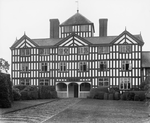Relief of Montgomery Castle
1644 in England1644 in WalesBattles of the English Civil WarsConflicts in 1644History of Montgomeryshire ... and 1 more
Wales in the English Civil War

The Battle of Montgomery took place during the First English Civil War of 1642–1646. On 17 September 1644, a Parliamentarian force commanded by Sir John Meldrum advanced to engage a Royalist army led by Lord Byron which was besieging Montgomery Castle in mid Wales. The battle was fought the next day. After the Royalists gained an initial advantage, the Parliamentarians counter-attacked and destroyed Byron's army. The Royalists retained a presence in North and Mid Wales after their defeat, but could not again gather a field army in the region until the end of the civil war.
Excerpt from the Wikipedia article Relief of Montgomery Castle (License: CC BY-SA 3.0, Authors, Images).Relief of Montgomery Castle
Castle Walk,
Geographical coordinates (GPS) Address Nearby Places Show on map
Geographical coordinates (GPS)
| Latitude | Longitude |
|---|---|
| N 52.56253 ° | E -3.15061 ° |
Address
Castell Trefaldwyn
Castle Walk
SY15 6ES , Montgomery
Wales, United Kingdom
Open on Google Maps









